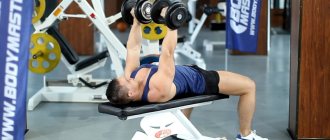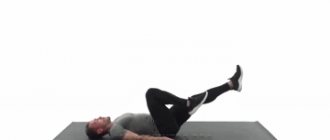If you don’t know how to do pull-ups yet, now is the time to learn. Pull-ups on the horizontal bar are an exercise that develops grip strength, increases the width of the back and helps elongate the spine.
They themselves are intermediate gymnastic movements. At the very beginning, lifting your own body weight seems like an impossible task, something completely incredible, but we will tell you how to start doing pull-ups on the bar from zero to 15-20 times in one approach.
You should not try to set goals to learn everything now and at once or look for something to replace this exercise. You must approach your goal gradually, without missing anything important. There are thousands of books on strategies and methods for learning how to do pull-ups from scratch, but not all of them can help you become really strong.
The method is designed so that a beginner can quickly train pull-ups from the simplest auxiliary exercises that will allow you to perform the first repetition from scratch to the most complex variations of this exercise.
How long does it take to learn?
If your body weight does not exceed 80-90 kilograms, then you can master the exercise and start doing it about 10 times in 2-3 weeks. If you are overweight, it is better to lose weight first. We recommend reading: how much weight you can lose in a month at home.
How to start doing pull-ups on the horizontal bar from scratch
Are you afraid of the crossbar? Are you scared of remembering the school gym? You are not alone. This movement remains a daunting exercise for many men. And this is bad, because few exercises can strengthen the entire upper body, affecting the core muscles and improving posture, like a simple pull-up.
Learning to perform this exercise correctly is important for any athlete, regardless of his goals. This is one of the most fundamental, basic exercises in the world of fitness. It is useful for both CrossFit and bodybuilding, and for sports enthusiasts. This exercise can be performed anywhere, either on the horizontal bar in the gym or on a tree branch in your yard. Pull-ups also target another muscle group you want to work: your back. Strong back muscles protect your shoulders from injury and also help all the other muscles in your body get the most benefit from other exercises, such as bench presses and curls.
But we must remember that technical pull-ups are difficult to learn for many reasons. First, you need to have mobility in your shoulder joints, which is difficult for many people to achieve. Secondly, you are lifting your entire body weight, which is simply not easy. Pull-ups can also be performed in different ways, making them even more challenging.
But we can explain everything to you. We will help you overcome all the difficulties that prevented you from correctly performing pull-ups - the gold standard of bodyweight exercises. And if you are still tormented by memories of the gym at school, you will find ways to overcome them too. It's time to step up to the bar and get to work.
Correct technique
The pull-up is a little more complicated than simply bringing your chin and bar together. You need to know the nuances that will allow you to strengthen your back and not harm your shoulders. The exercise can be viewed in three different phases: starting at the bottom, the middle position, and the top position, which is the most difficult position to pull.
Where to begin
Never let tension go away from your back. Your arms should be fully extended, but your body should not hang. Maintain constant tension in the shoulder muscles, the muscles around the shoulder blades and the collarbone. Don't let your body hang completely because your shoulders will end up near your ears. Then most of the load will fall on the relatively weak biceps ligaments - this is undesirable.
In the middle of the exercise
Watch your shoulder blades. When you start to pull up, don't just use your arms. Instead, engage other muscles—pull your shoulder blades down and back as your elbows move toward your ribs. "You control your shoulders and shoulder blades using the 'natural rhythm of the shoulder,'" says Jeff Cavaliere, physical therapist and trainer. This is the key to shoulder health and proper technical execution of the movement. In the video below, he explains the real reasons why you can't do pull-ups.
Have you reached the top? Do not stop
Try to finish the repetition. When your chin is over the bar, don't stop pulling. Try to rise higher by squeezing your shoulder blades. Pull even if you don't go higher. As you do this, try to keep tension in your glutes and abdominal muscles. Your torso may lean back slightly, causing your hips and legs to be in front of the bar. This is not a problem, but you should not push your shoulders in front of the horizontal bar. This can injure the shoulder muscles.
Which option is better and more correct?
There are three main types of pull-ups that are most often performed in gyms. There are classic full-hang variations in which you lower your torso until your arms are fully extended, and then pull up to the maximum. There are also constant tension pull-ups, which are especially popular with bodybuilders. When performing this variation, the athlete lowers himself, but not completely. Without relaxing the muscles, he begins the next repetition. Finally, there is also a rocking variation where you swing your hips to create momentum that will help you reach the bar. This variety is preferred in CrossFit.
Which version of pull-ups is better? This depends on your goal as well as the strength of your shoulder joints.
With full hang
At the beginning of the exercise, completely relax all the muscles of the shoulders and back.
Let's take a break. We'll pick up from here. Pro : You perform a full range of motion, which gives your back muscles a good stretch. And a pause will prevent you from cheating.
Con : The ligaments and tendons of the shoulder are at risk of injury or sprain.
With constant voltage
This is the gold standard of pull-ups; you must maintain tension in your back muscles. The most important thing is to get the most out of this exercise. Constant tension is not a reason to only go halfway. Your elbows should still be fully extended and your shoulders should be slightly less than fully relaxed.
Pros : You have the opportunity to strengthen your back and arms while not risking shoulder ligament damage.
Cons : This version is more difficult to complete than it seems at first glance. Eight such pull-ups will be difficult even for a physically developed person.
With rocking
This version of the exercise allows you to swing your hips (and, as a result, your shoulders). This gives you momentum, which makes lifting easier.
Pros : This option primarily develops endurance, although the upper body muscles are also stressed. Pull-ups are a difficult exercise, so twenty repetitions is almost impossible to complete. But if you add swinging, the number of repetitions becomes much higher.
Con : If your shoulders have poor stability, you can easily injure them. Think twice before doing such exercises. In order for such pull-ups to work well, you must first master the version with full hanging and constant tension.
Lack of strength
Many guys manage to join the army and learn how to do pull-ups in just a year from scratch, even if in civilian life they were not able to raise their body to eye level. How is military training different from that carried out in gyms? Everything is very simple: in addition to training on the horizontal bar and parallel bars, a soldier has to perform several dozen, or even hundreds of push-ups a day. This exercise is one of the best for that person who cannot even support his weight on the bar. However, learning to do push-ups will be much easier.
First, it’s worth assessing your capabilities in order to create a competent preparatory course for pull-ups. To do this, you need to hang on the crossbar and try to hang on it for a minute. If you can’t do this, then you need to master the push-up technique. It’s good if you can perform 3-5 maximum correct repetitions with a straight back. However, if you can’t do a single push-up, then you need to train with some object, for example, uneven bars or the same crossbar. As your body weight increases, you need to make sure that the support becomes lower and lower.
Also, the task of any athlete during push-ups is to follow the correct technique. There will be very little use from those exercises that are performed in a hurry or not all the way to the floor. It is important to follow a certain pattern so as not to forget how to exercise even after several decades:
- Starting position: back straight, palms facing each other and at shoulder level.
- A proper push-up should be performed slowly—one to two seconds.
- Returning to the starting position should be as fast as possible.
It is also important to maintain a straight back position during training. If it rises high, then such push-ups will not be of much use.
As soon as the athlete feels that he is able to perform more than 10 correct push-ups, he needs to start training with additional load, and also from time to time go to the horizontal bar and try to pull himself up. Such training will continue to make a significant contribution to muscle development, and will also help you learn how to do pull-ups several times faster.
Pull-ups on the horizontal bar. Which grip is better for doing pull-ups - a review of techniques
Lead-up exercises
Very few people can step up to a bar and do a lot of pull-ups at once without a lot of preparation beforehand. Let us remember again that this is a rather complex technique; It's not easy to lift your own body weight over and over again.
But once you can master the simple pull-up, there are a whole host of variations you can try. Once you can complete the progression described above, you can experiment with the ideas outlined below. Some of them will help you do more pull-ups, and some will just be more difficult variations.
How to quickly learn to do a lot of pull-ups
Still studying?
Accelerate your progress by doing these 5 pull-up assistance exercises to start doing even more than 20 reps in one set: Hold : Stand on a box under the bar and jump up to the top position of the exercise. Hold there as long as possible, tensing your back muscles. Try to hold out for at least 20 seconds.
Reverse pull-up : Stand on a box under the bar and jump to the top position. Stay there for just a second. After this, begin to slowly lower yourself to the starting position. The lowering process should take at least five seconds. Perform three sets of five repetitions.
Horizontal pull-ups from hanging lying on a low bar : the bar should be low in relation to the floor. You can use any stick thrown between the chairs. Grab the bar and lean back so your torso is parallel to the floor, pressing into your heels and pulling your chest toward the bar. This is one repetition. You need to do three sets of fifteen repetitions. No, this is not the same as the classic exercise, but it will still help you develop the muscle strength needed to perform pull-ups correctly.
In addition to the techniques described, you can also perform these twice a week:
Low reps : Perform only one or two reps before lowering to the floor. In the first week, perform five sets of one repetition, and in the second week, perform four sets of two repetitions.
Lightweight option : here we will use an expander thrown over the crossbar. We put our feet on the expander so that it helps to do pull-ups. Try to do 2 sets of 8 repetitions.
Scapular pull-ups : While hanging from a bar, extend your arms. Squeeze your shoulder blades together. Hold for one second and relax. It was one repeat. Perform two sets of 10-15 repetitions.
Which leg position should you choose?
Lesson scheme for beginners
The following monthly diagram will help you learn how to do pull-ups correctly on the horizontal bar:
- First week. During this period, daily exercises are performed on the horizontal bar with support on the legs.
- Second 7 days. To the previous exercise add hanging on the horizontal bar for 1 minute.
- Third stage. The circuit includes Australian pull-ups and hangs. Each action is performed 3-4 times.
- Fourth week. The duration of the hang is increased to 2 minutes, the number of pull-ups is increased to 15.
Your training plan can include pull-ups with loops and exercises with additional weight. If it is not possible to achieve a positive result quickly, the pace of learning slows down.
How long does it take to learn to do pull-ups?
If you practice a lot and use good techniques, you can learn how to perform the exercise in 1-2 months. With poor physical fitness, the process can take up to six months.
Are you ready for difficulties? Try these varieties too
Loaded pull-ups : To get stronger you need to add intensity, not repetition. Try doing three sets of 10 reps while wearing a weighted vest.
Mixed-grip pull-ups : This is a more useful variation: grab the bar with one hand from below and the other from above. When performing the exercise, try to maintain balance. Don't let your hips move to the left or right.
Plyometric pull-ups : pull yourself up sharply and, reaching the top point of the exercise, throw yourself up and release the horizontal bar. Your hands should come off the bar. In a second, catch her again. Too easy? Try catching him with an underhand grip.
Cable pull-ups : Works the arm muscles, but this variation doubles the load on the hand muscles. We perform the movement holding the ends of the rope with both hands.
Pull-ups with corner hold : in the starting position, press your legs together and extend them forward, creating an L shape with your torso. Tighten your abdominal muscles. Keep your torso in this position as you perform pull-up reps.
Archer Pull-Ups : As you rise, shift your torso to the left side, extending your right arm as your chest approaches the bar. Lower yourself, then do the same on the other side with your left arm straight.
What muscles swing when doing a pull-up?
As mentioned above, with the help of a horizontal bar, several muscle groups are pumped at once. Depending on the pull-up method you choose, you can adjust the load on a particular muscle. But first, let's still find out which muscles swing when doing pull-ups on the horizontal bar.
When doing pull-ups on the horizontal bar, the following are used:
- Trapezoid;
- Latissimus dorsi muscles;
- Triceps;
- Biceps;
- Delta;
- Shoulders;
- Forearms;
- Press et al.











